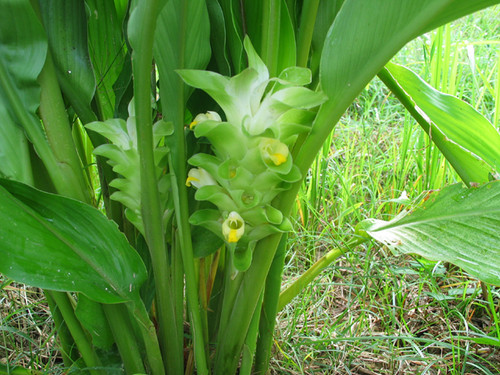Tumeric Benefits
Tumeric is a beautiful herb that is a close cousin to Ginger. It is native to India and South Asia. Tumeric is a traditional spice used in India cooking and also Asian dishes. Tumeric is the yellow color in curry dishes. The vibrant, beautiful yellow color of the roots have been used as dyes for fabric. While widely used in India and Asia for centuries, it has more recently become popular in North America.
This is a stunning herb when planted in the garden. It likes warm, moist, tropical conditions. It can be grown in pots but be prepared for this plant to grow to 3 to 5 feet tall. First to show are the beautiful flowers that are white, yellow and then red on the top. The flowers spike up from the ground and then the leaves show up almost covering the flower. Plant the rhizome shallow in rich soil, keep moist and in full sun.
The most popular ways to use this plant are the powder for cooking and capsules for medicinal purposes. In Chinese medicine, it is cooked into a tea. This is a very powerful herb with multiple healing properties. It is an exceptional antioxidant which rivals Vitamin E. It’s anti-inflammatory properties are said to be stronger than hydrocortisone, with none of the side effects. Traditional uses in Ayurvedic and Traditional Chinese Medicine are for jaundice and liver and gall bladder issues. Tumeric also has fat burning properties by stimulating the production of bile helping to digest fats. For more on the fat burning capabilities of tumeric go to www.getbiggerabs.com and click on the tumeric post.
Curcumin is one of the main constituents and is an effective antibacterial agent. Recent studies of curcumin are finding it is proving to be a powerful agent in fighting against breast cancer, prostate cancer, colon and skin cancers, as well. British Journal of Cancer published research showing curcumin very effective against esophageal cancer cells within 24 hours of treatment. Other studies show promising results with lymphoma cells.
Chinese research in the 80’s found it lowers blood cholesterol levels and has anti-coagulant actions, preventing blood clots. It is also used as a digestive aid to stimulate the production of bile, therefore, aiding the liver and gallbladder. It also stimulates digestive microflora that inhibits yeast overgrowth.
Parts used: Rhizome
Key constituents: Essential oils (containing zingiberene and turmerone), curcumin, bitters, resins.
Properties: Pungent, spicy, warming, drying and moving.
Actions: Anti-inflammatory, Antioxidant, Antibacterial, Antidepressant
Cautions: There aren’t really any cautions, the only thing to be cautious of is the drying and warming qualities. However, you can counter balance that affect by using cooling and moistening herbs.
